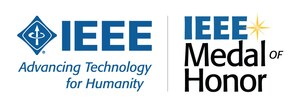LOS ANGELES, March 6, 2012 /PRNewswire/ -- With broadband communication demands rapidly growing around the world, engineering members from IEEE, the world's largest technical professional association, are identifying areas in the optical fiber and telecommunications industry that could be affected by advances in the consumption of data and the requirements for increased speed.
(Logo: http://photos.prnewswire.com/prnh/20120306/NY65270LOGO )
Although fiber capacity demonstrations have recently reached the milestone of transmitting 100 terabits of data per second through a single optical fiber, based on traffic growth trends, fiber capacity will need to stretch even further to meet the escalating demand being created by enterprises and consumers around the world.
"Current data center technologies and architectures will be unable to cope with the rapidly increasing traffic volume, and will have to evolve to accommodate higher bandwidth and better energy efficiency," said Dr. Leonid Kazovsky, an IEEE Fellow and professor at Stanford University. "At the same time, the rest of the network will need to evolve as well. So, we must look into future technologies, architectures and infrastructure options that can effectively create "express lanes" for large amounts of traffic, the same way express lanes on our highways allow high occupancy vehicles to get to their destinations more quickly."
Experts note that the dramatic rise in the viewing and access of video content will be a main driver of optical fiber innovation and deployment in the next several years, not only in the provisioning of the network – but within the data center itself.
"The emergence of new data centers, changes in peering arrangements and the rise of new Over-the-Top (OTT) players are creating reduced predictability of traffic in the network," said Ori Gerstel, an IEEE Fellow and principal engineer at Cisco in Israel. "Video content provided by OTT providers like YouTube, Netflix, and Hulu and peer-to-peer file sharing networks dramatically affect traffic patterns and are therefore driving the need for a more agile and simplified optical fiber network."
Other engineering experts cite the bandwidth demands of consumers and enterprise as the priority issue for optical communications engineers to address.
"Though fragmented right now, we see next generation optical access driving the network consolidation of residential and business services," said Jun Shan Wey, an IEEE Senior Member and standards manager, Industry Environment, CTO Office at Nokia Siemens Networks. "From a global perspective, Asia is really driving this. Taiwan's government for example, is talking about giving people 1G broadband access in their homes, access which had only been previously offered to businesses."
Dr. Kazovsky and other industry leaders believe that one of the most important topics for attendees of the OFC/NFOEC to address is access networks, and the integration with wireless networks.
"Optical access networks are especially important and wireless networks are important as well; even more important is integration between the two," said Dr. Kazovsky. "Some years from now, the role of copper will be much smaller than it is today, and future networks will rely mostly on fiber and wireless technologies. That is more or less a given. But how that will come and how optical and wireless technologies will be integrated in the future remains an open question. Substantial investments will be made in these fields, and this is an area that needs to be watched very closely. One thing is clear: companies that make the right bet will flourish."
"Advances in optical fiber technology are increasingly affecting global business operations and consumers' ability to have rapid access to high quality content," says Gordon Day, IEEE President and CEO. "IEEE is very proud to be a part of the optical fiber industry's foremost gathering of innovators and researchers across business and academia. New developments in optical fiber technology discussed at OFC/NFOEC promise to deliver incredible advances in how the world communicates and collaborates in the years ahead."
About IEEE
IEEE, the world's largest technical professional association, is dedicated to advancing technology for the benefit of humanity. Through its highly cited publications, conferences, technology standards, and professional and educational activities, IEEE is the trusted voice on a wide variety of areas ranging from aerospace systems, computers and telecommunications to biomedical engineering, electric power and consumer electronics.
Learn more at http://www.ieee.org.
Join IEEE at http://www.ieee.org/join.
About OFC/NFOEC
For more than 35 years, the Optical Fiber Communication Conference and Exposition/ National Fiber Optic Engineers Conference (OFC/NFOEC) has been the premier destination for converging breakthrough research and innovation in telecommunications, optical networking and, recently, datacom and computing. Uniting service providers, systems companies, enterprise customers, IT businesses and component manufacturers, along with researchers, engineers and development teams, OFC/NFOEC combines dynamic business programming, an exposition of more than 500 companies and cutting-edge peer-reviewed research into one event that showcases the trends and pulse of the entire optical communications industry.
OFC/NFOEC is managed by the Optical Society (OSA) and co-sponsored by OSA, the Institute of Electrical and Electronics Engineers/Communications Society (IEEE/ComSoc) and the IEEE Photonics Society. Acting as a non-financial technical co-sponsor is Telcordia Technologies, Inc. Visit www.ofcnfoec.org
Media Contacts:
Owen Donnelly
Finn Partners for IEEE
312-329-3910
[email protected]
Tracey Caliendo
IEEE
732-465-7811
[email protected]
SOURCE IEEE
WANT YOUR COMPANY'S NEWS FEATURED ON PRNEWSWIRE.COM?
Newsrooms &
Influencers
Digital Media
Outlets
Journalists
Opted In





Share this article